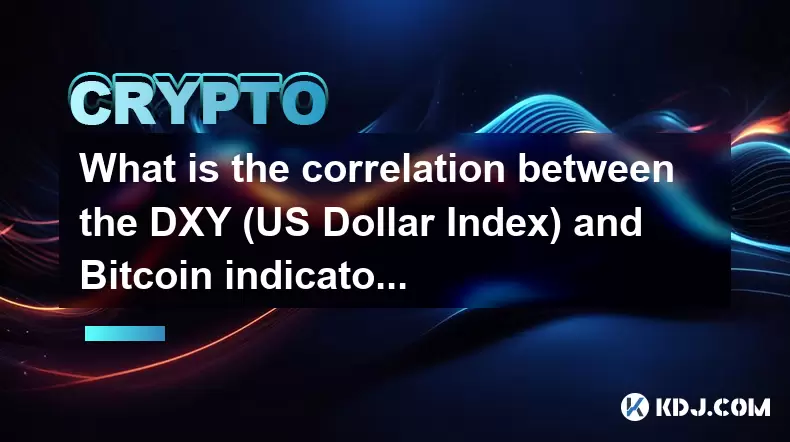-
 bitcoin
bitcoin $100977.009184 USD
-2.05% -
 ethereum
ethereum $3282.009150 USD
-3.23% -
 tether
tether $0.999813 USD
-0.02% -
 xrp
xrp $2.208254 USD
-4.89% -
 bnb
bnb $951.411089 USD
0.55% -
 solana
solana $155.761205 USD
-2.84% -
 usd-coin
usd-coin $1.000217 USD
0.02% -
 tron
tron $0.284475 USD
-1.28% -
 dogecoin
dogecoin $0.162363 USD
-1.53% -
 cardano
cardano $0.533988 USD
-0.47% -
 hyperliquid
hyperliquid $39.174339 USD
-3.22% -
 chainlink
chainlink $14.724828 USD
-1.16% -
 bitcoin-cash
bitcoin-cash $477.297986 USD
-1.28% -
 zcash
zcash $554.227426 USD
17.30% -
 ethena-usde
ethena-usde $0.998995 USD
-0.03%
What is the correlation between the DXY (US Dollar Index) and Bitcoin indicators?
The DXY and Bitcoin often show inverse trends, with a stronger dollar sometimes pressuring crypto prices, though other factors like regulation and market sentiment play key roles.
Jul 06, 2025 at 02:22 am

Understanding the DXY (US Dollar Index)
The DXY (US Dollar Index) is a measure of the value of the United States dollar relative to a basket of foreign currencies. These currencies include the Euro, Japanese Yen, British Pound, Canadian Dollar, Swedish Krona, and Swiss Franc. The index was introduced by the Federal Reserve in 1973 and has since been used as a benchmark for assessing the strength of the U.S. dollar globally.
When the DXY rises, it indicates that the U.S. dollar is strengthening compared to its counterparts. Conversely, a falling DXY implies a weakening dollar. Traders and analysts monitor the DXY closely because it reflects broader macroeconomic conditions, interest rate policies, and geopolitical stability.
Bitcoin as a Decentralized Digital Asset
Bitcoin operates outside traditional financial systems and is not tied to any central bank or government. It is often referred to as 'digital gold' due to its limited supply and perceived store-of-value properties. However, Bitcoin also exhibits characteristics of a speculative asset, with prices heavily influenced by market sentiment, regulatory news, and macroeconomic trends.
Despite being decentralized, Bitcoin’s price can be indirectly affected by movements in traditional financial markets, including currency fluctuations. This has led to increased interest in how Bitcoin correlates with major economic indicators like the DXY.
Historical Correlation Patterns Between DXY and Bitcoin
Over time, various studies and market observations have attempted to establish a correlation between the DXY and Bitcoin price movements. While there is no consistent one-to-one relationship, certain patterns have emerged:
- During periods of dollar weakness, investors may seek alternative assets like Bitcoin to hedge against inflation or currency devaluation.
- In times of dollar strength, capital may flow back into the USD from riskier assets, including cryptocurrencies, leading to downward pressure on Bitcoin’s price.
It's important to note that this correlation is not static and can vary depending on global economic conditions, investor behavior, and policy changes.
How Macroeconomic Factors Influence Both Markets
Several macroeconomic factors simultaneously impact both the DXY and Bitcoin:
- Interest Rate Decisions: When the U.S. Federal Reserve raises interest rates, the dollar typically strengthens, which may coincide with a pullback in crypto prices.
- Inflation Expectations: Rising inflation can weaken the dollar, potentially boosting demand for Bitcoin as an inflation hedge.
- Risk-On/Risk-Off Sentiment: During market volatility, investors may either flee to the safety of the U.S. dollar or move toward high-risk assets like Bitcoin.
These overlapping influences create a dynamic where Bitcoin and the DXY may move inversely at times, but not always predictably.
Technical Analysis: Observing Indicator Overlaps
From a technical standpoint, traders often overlay charts of the DXY and Bitcoin to identify potential trend reversals or momentum shifts. Some common tools used include:
- Relative Strength Index (RSI): Helps determine overbought or oversold conditions in both the DXY and Bitcoin.
- Moving Averages: Used to smooth out price data and identify prevailing trends.
- Correlation Coefficient Indicators: These help quantify the degree to which Bitcoin and the DXY are moving together or diverging.
Traders should be cautious when interpreting these signals, as correlation does not imply causation. Other external variables such as regulatory developments or macroeconomic shocks can override observed technical relationships.
Case Studies: Notable Instances of DXY-Bitcoin Interaction
There have been several notable instances where Bitcoin and the DXY moved in tandem or opposition:
- In early 2020, amid the global pandemic, the DXY initially spiked due to a flight to safety, while Bitcoin plummeted. As stimulus measures were announced and the dollar weakened, Bitcoin rallied sharply.
- In late 2021, as inflation concerns grew, the DXY began to strengthen again, coinciding with a cooling period for Bitcoin and other cryptocurrencies.
These examples illustrate how market psychology and macroeconomic forces can shape the interaction between the DXY and Bitcoin, though outcomes are not guaranteed.
Frequently Asked Questions
Q1: Does a rising DXY always lead to a drop in Bitcoin prices?No, while a stronger dollar can sometimes correlate with lower crypto prices, this is not a rule. Other factors such as investor sentiment, technological developments, and regulatory news can override the influence of the DXY.
Q2: Can Bitcoin ever become decoupled from traditional financial indicators like the DXY?There is ongoing debate about whether Bitcoin will eventually decouple from traditional markets. Currently, its price remains sensitive to macroeconomic conditions, but long-term decoupling could occur if adoption grows significantly and institutional investment becomes more dominant.
Q3: How can I track the real-time relationship between the DXY and Bitcoin?You can use platforms like TradingView or CoinMarketCap to overlay DXY and Bitcoin price charts. Many charting tools allow you to plot multiple assets on the same graph and apply correlation analysis indicators.
Q4: Should retail investors focus on DXY when making Bitcoin trading decisions?Retail investors should consider the DXY as one of many tools in their analytical toolkit. Relying solely on the DXY can be misleading without considering broader market dynamics and individual risk tolerance.
Disclaimer:info@kdj.com
The information provided is not trading advice. kdj.com does not assume any responsibility for any investments made based on the information provided in this article. Cryptocurrencies are highly volatile and it is highly recommended that you invest with caution after thorough research!
If you believe that the content used on this website infringes your copyright, please contact us immediately (info@kdj.com) and we will delete it promptly.
- BlockDAG, Avalanche, Dogecoin: Crypto's Leading Trio in 2025
- 2025-11-07 22:05:01
- Layer 2 Coins: Will There Be a Potential Explosion by 2026?
- 2025-11-07 16:50:02
- Filecoin, ICP, and the AI Infrastructure Renaissance: Is History Repeating?
- 2025-11-07 16:50:02
- Bitcoin's Wild Ride: Surges, Zeros, and the Search for Stability
- 2025-11-07 17:05:01
- XRP, Bitcoin, and the Rally: What's the Deal, New York?
- 2025-11-07 17:25:01
- Filecoin, DePIN, and a Technical Breakout: What's the Buzz?
- 2025-11-07 17:05:01
Related knowledge

What is the total supply of Bitcoin?
Oct 10,2025 at 01:55pm
Total Supply of Bitcoin1. The total supply of Bitcoin is capped at 21 million coins. This limit is hardcoded into the Bitcoin protocol and cannot be a...

Can you buy a fraction of a Bitcoin?
Oct 10,2025 at 06:01pm
Understanding Fractional Bitcoin Ownership1. Yes, you can buy a fraction of a Bitcoin. The smallest unit of Bitcoin is called a satoshi, which represe...

How to buy Bitcoin for the first time?
Oct 21,2025 at 11:00am
Understanding Bitcoin and Its Value1. Bitcoin is a decentralized digital currency that operates on a peer-to-peer network without the need for interme...

Why is Bitcoin considered a revolutionary technology?
Aug 12,2025 at 08:29pm
Decentralization and the Elimination of Central AuthoritiesThe core innovation behind Bitcoin lies in its decentralized architecture, which fundamenta...

Why is Bitcoin considered a revolutionary technology?
Aug 10,2025 at 07:42pm
Decentralized Architecture and Trustless TransactionsBitcoin is considered revolutionary because it introduced a decentralized architecture that opera...

What are the key features of Bitcoin?
Aug 10,2025 at 02:50am
Decentralization and Peer-to-Peer NetworkOne of the most defining characteristics of Bitcoin is its decentralized nature. Unlike traditional financial...

What is the total supply of Bitcoin?
Oct 10,2025 at 01:55pm
Total Supply of Bitcoin1. The total supply of Bitcoin is capped at 21 million coins. This limit is hardcoded into the Bitcoin protocol and cannot be a...

Can you buy a fraction of a Bitcoin?
Oct 10,2025 at 06:01pm
Understanding Fractional Bitcoin Ownership1. Yes, you can buy a fraction of a Bitcoin. The smallest unit of Bitcoin is called a satoshi, which represe...

How to buy Bitcoin for the first time?
Oct 21,2025 at 11:00am
Understanding Bitcoin and Its Value1. Bitcoin is a decentralized digital currency that operates on a peer-to-peer network without the need for interme...

Why is Bitcoin considered a revolutionary technology?
Aug 12,2025 at 08:29pm
Decentralization and the Elimination of Central AuthoritiesThe core innovation behind Bitcoin lies in its decentralized architecture, which fundamenta...

Why is Bitcoin considered a revolutionary technology?
Aug 10,2025 at 07:42pm
Decentralized Architecture and Trustless TransactionsBitcoin is considered revolutionary because it introduced a decentralized architecture that opera...

What are the key features of Bitcoin?
Aug 10,2025 at 02:50am
Decentralization and Peer-to-Peer NetworkOne of the most defining characteristics of Bitcoin is its decentralized nature. Unlike traditional financial...
See all articles





















![The Graph Price Prediction [GRT Crypto Price News Today] The Graph Price Prediction [GRT Crypto Price News Today]](/uploads/2025/11/07/cryptocurrencies-news/videos/690d4df44fe69_image_500_375.webp)




















































